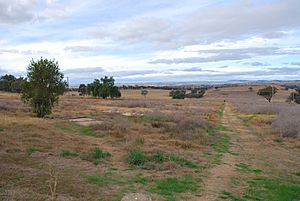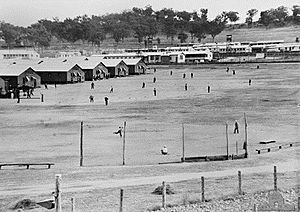Cowra Prisoner of War Camp Site facts for kids
Quick facts for kids Cowra Prisoner of War Camp Site |
|
|---|---|

Ruins of the prisoner-of-war-camp, 2011
|
|
| Location | Evans Street, Cowra, Cowra Shire, New South Wales, Australia |
| Built | 1941–1944 |
| Owner | Cowra Shire Council |
| Official name: Cowra Prisoner of War Camp Site; POW | |
| Type | state heritage (archaeological-terrestrial) |
| Designated | 2 April 1999 |
| Reference no. | 619 |
| Type | Internment Camp |
| Category | Law Enforcement |
| Builders | Australian soldiers and POWs |
| Lua error in Module:Location_map at line 420: attempt to index field 'wikibase' (a nil value). | |
The Cowra Prisoner of War Camp Site is a special historical place in Cowra, New South Wales, Australia. It was a camp built during World War II to hold prisoners of war. A very important event, known as the Cowra breakout, happened here in 1944. Today, the site is owned by the Cowra Shire Council and is a protected heritage site. It was added to the New South Wales State Heritage Register on 2 April 1999.
Contents
What Was the Cowra POW Camp?
The Cowra Prisoner of War Camp was built between 1941 and 1942. It was designed to hold Italian prisoners captured by Allied forces during World War II. Australia had many such camps across the country.
The Cowra camp was planned to have four main areas. Building work continued until 1944. Both prisoners and local workers helped build the camp. The first prisoners arrived in October 1941. They lived in tents until proper huts were ready in April 1942.
Prisoners at Cowra
By December 1942, over 2,000 prisoners were living at the camp. Most of these were Italian. Between January 1943 and August 1944, over one thousand Japanese prisoners also arrived. By mid-1944, the camp was very crowded.
The Cowra Breakout
At 2 am on 5 August 1944, the Japanese prisoners tried to escape. This event is known as the Cowra Breakout. Over 300 prisoners managed to get out. Sadly, more than 250 prisoners died during the escape attempt. During the breakout, 18 buildings were burned down.
This event was very important because it was the only time during World War II that fighting happened on Australian land. It was also the biggest prison revolt in Australia's history. The breakout often makes people forget about the experiences of the Italian and other prisoners who were also held at the camp.
After the War
After World War II ended, parts of the camp were sold. Some land went to the New South Wales Department of Agriculture. Other parts were sold to private owners. Today, some of the site is a public reserve. The private parts are used for farming.
In 1991, Cherry Tree Avenue was extended across the camp site. This road now connects to the War Cemetery and the Cowra Japanese Garden and Cultural Centre.
What Can You See at the Site Today?
The camp site is on gently sloping land, away from the town. Most of the original fences, paths, and buildings are no longer standing. However, you can still see parts of old floor slabs, foundations, and drainage lines. These have been found using aerial photos.
There is one ruined building still standing in the Headquarters area. It has four walls made from stone, bricks, and concrete blocks. You can also see signs of where a shallow roof once was. Two original timber huts from the camp were sold after the war and are still intact off-site.
Even though not much is left above ground, the site has a lot of hidden history. Archaeologists can find many clues underground. This helps us understand what life was like at the camp.
Why is the Cowra Camp Site Important?
The Cowra Prisoner of War Camp Site is a very important historical place. It is listed on the New South Wales State Heritage Register because of its special history and meaning.
A Link to World War II
This site is a key part of Australia's history during World War II. It shows how the war affected Australia directly. The Cowra Breakout was the only land battle on the Australian mainland during the war. This makes the site unique.
Connecting Cultures
The camp held prisoners from many different countries, including Italy and Japan. The events at Cowra, especially the breakout, created a strong link between Cowra and Japan. Many Japanese lives were lost here, which gives the site deep cultural and spiritual meaning for the Japanese people. This special connection has helped shape Cowra's identity since the war. It is a unique example of cultural ties in Australia.
Learning from the Past
The physical remains and archaeological findings at the site can teach us a lot. They show us the building methods used at the time. They also help us understand the daily lives of both the guards and the prisoners. The site helps us learn about the experience of prisoners of war in Australia during World War II.


